Show code cell content
import numpy as np
import scipy as sp
import matplotlib.pyplot as plt
import pandas as pd
import seaborn as sns
import matplotlib as mp
import sklearn
from IPython.display import Image
%matplotlib inline
Low Rank Approximation and the SVD#
Today, we move on.
However, let’s look back and try to put the modeling we’ve done into a larger context.
Models are simplifications#
One way of thinking about modeling or clustering is that we are building a simplification of the data.
That is, a model of the data that is simpler than the data.
In particular, instead of thinking of the data as thousands or millions of individual data points, we think of it in terms of a small number of clusters, or a parametric distribution, etc, etc.
From this simpler description, we hope to gain insight.
There is an interesting question here: why does this process often lead to insight?
That is, why does it happen so often that a large dataset can be described in terms of a much simpler model?
I don’t know.

By self-created (Moscarlop) - Own work, CC BY-SA 3.0, Link
However, I think that William of Ockham (c. 1300 AD) was on the right track.
He said:
Non sunt multiplicanda entia sine necessitate
or, in other words:
Entities must not be multiplied beyond necessity.
by which he meant:
Among competing hypotheses, the one with the fewest assumptions should be selected.
Which has come to be known as “Occam’s razor.”
William was saying that it is more common for a set of observations to be determined by a simple process than a complex process.
In other words, the world is full of simple (but often hidden) patterns.
From which one can justify the observation that “modeling works suprisingly often.”
Data Matrices#
Now we’ll consider a (seemingly) very different approximation of data, applicable to data when it is in matrix form.
| Data Type | Rows | Columns | Elements |
|---|---|---|---|
| Network Traffic | Sources | Destinations | Number of Bytes |
| Social Media | Users | time bins | Number of Posts/Tweets/Likes |
| Web Browsing | Users | Content Categories | Visit Counts/Bytes Downloaded |
| Web Browsing | Users | time bins | Visit Counts/Bytes Downloaded |
Matrix Rank#
Let’s briefly review some definitions.
We’ll consider an \(m\times n\) real matrix \(A\).
The rank of \(A\) is the dimension of its column space.
The dimension of a space is the smallest number of (linearly independent) vectors needed to span the space.
So the dimension of the column space of \(A\) is the smallest number of vectors that suffice to construct the columns of \(A\).
Then the rank of \(A\) is the size of the smallest set \(\{\mathbf{u}_1, \mathbf{u}_2, \dots, \mathbf{u}_p\}\) such that every column \(\mathbf{a}_i\) can be expressed as:
The largest value that a matrix rank can take is \(\min(m,n)\).
However it can happen that the rank of a matrix is less than \(\min(m,n)\).
Now to store a matrix \(A \in \mathbb{R}^{m\times n}\) we need to store \(m n\) values.
However, if \(A\) has rank \(k\), it can be factored as \(A = UV\),
where \(U \in \mathbb{R}^{m\times k}\) and \(V \in \mathbb{R}^{k \times n}\).
This only requires \(k(m+n)\) values, which could be much smaller than \(mn\).
Low Effective Rank#
In many situations we may wish to approximate a data matrix \(A\) with a low-rank matrix \(A^{(k)}.\)
To talk about when one matrix “approximates” another, we need a norm for matrices.
We will use the Frobenius norm which is just the usual \(\ell_2\) norm, treating the matrix as a vector.
The definition of the Frobenius norm of \(A\), denoted \(\Vert A\Vert_F\), is:
To quantify when one matrix is “close” to another, we use distance in Euclidean space:
(where the Euclidean space is the \(mn\)-dimensional space of \(m\times n\) matrices.)
Now we can define the rank-\(k\) approximation to \(A\):
When \(k < \operatorname{Rank} A\), the rank-\(k\) approximation to \(A\) is the closest rank-\(k\) matrix to \(A\), i.e.,
This can also be considered the best rank-\(k\) approximation to \(A\) in a least-squares sense.
Let’s say we have \(A^{(k)}\), a rank-\(k\) approximation to \(A\).
By definition, there is a set \(\mathcal{U}\) consisting of \(k\) vectors such that each column of \(A^{(k)}\) can be expressed as a linear combination of vectors in \(\mathcal{U}\).
Let us call the matrix formed by those vectors \(U\).
So
for some set of coefficients \(V^T\) that describe the linear combinations of \(U\) that yield the columns of \(A^{(k)}\).
So \(U\) is \(m\times k\) and \(V\) is \(n\times k\).
If we approximate \(A\) by \(A^{(k)}\), then the error we incur is:
Hence, a rank-\(k\) approximation \(A^{(k)}\) is valuable if
\(\Vert A-A^{(k)}\Vert_F\) is small compared to \(\Vert A\Vert_F\), and
\(k\) is small compared to \(m\) and \(n\).
In that case we have achieved a simplification of the data without a great loss in accuracy.
Finding Rank-\(k\) Approximations#
There is a celebrated method for finding the best rank-\(k\) approximation to any matrix: the Singular Value Decomposition (SVD).
SVD is “the Rolls-Royce and the Swiss Army Knife of Numerical Linear Algebra.”
Dianne O’Leary, MMDS ’06
The singular value decomposition of a rank-\(r\) matrix \(A\) has the form:
where
\(U\) is \(m\times r\)
The columns of \(U\) are mutually orthogonal and unit length, ie., \(U^TU = I\).
\(V\) is \(n\times r\).
The columns of \(V\) are mutually orthogonal and unit length, ie., \(V^TV = I\).
The matrix \(\Sigma\) is an \(r\times r\) diagonal matrix, whose diagonal values are \(\sigma_1 \geq \sigma_2 \geq \dots \geq \sigma_r > 0\).
Npw, the SVD is incredibly useful for finding matrix approximations.
In particular, for an \(m\times n\) matrix \(A\), the SVD does two things:
It gives the best rank-\(k\) approximation to \(A\) for every \(k\) up to the rank of \(A\).
It gives the distance of the best approximation \(A^{(k)}\) from \(A\) for each \(k\).
In terms of the singular value decomposition,
The best rank-\(k\) approximation to \(A\) is formed by taking
\(U' = \) the \(k\) leftmost columns of \(U\),
\(\Sigma' = \) the \(k\times k\) upper left submatrix of \(\Sigma\), and
\(V'= \) the \(k\) leftmost columns of \(V\), and constructing
Furthermore, the distance (in Frobenius norm) of the best rank-\(k\) approximation \(A^{(k)}\) from \(A\) is equal to \(\sqrt{\sum_{i=k+1}^r\sigma^2_i}\).
That is, if you construct \(A^{(k)}\) as shown above, then:
Low Effective Rank#
Almost any data matrix \(A\) that one encounters will usually be full rank,
meaning that \(\operatorname{Rank} A = \min(m, n)\).
However, it is often the case that data matrices have low effective rank.
By this we mean that one can usefully approximate \(A\) by some \(A^{(k)}\) for which \(k \ll \min(m,n)\).
For any data matrix, we can judge when this is the case by looking at its singular values, because the singular values tell us the distance to the nearest rank-\(k\) matrix.
Empirical Evidence#
Let’s see how this theory can be used in practice, and investigate some real data.
We’ll look at data traffic on the Abilene network:
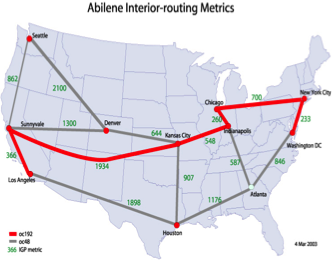
Source: Internet2, circa 2005
with open('data/net-traffic/AbileneFlows/odnames','r') as f:
odnames = [line.strip() for line in f]
dates = pd.date_range('9/1/2003', freq = '10min', periods = 1008)
Atraf = pd.read_table('data/net-traffic/AbileneFlows/X', sep=' ', header=None, names=odnames, engine='python')
Atraf.index = dates
Atraf
| ATLA-ATLA | ATLA-CHIN | ATLA-DNVR | ATLA-HSTN | ATLA-IPLS | ATLA-KSCY | ATLA-LOSA | ATLA-NYCM | ATLA-SNVA | ATLA-STTL | ... | WASH-CHIN | WASH-DNVR | WASH-HSTN | WASH-IPLS | WASH-KSCY | WASH-LOSA | WASH-NYCM | WASH-SNVA | WASH-STTL | WASH-WASH | |
|---|---|---|---|---|---|---|---|---|---|---|---|---|---|---|---|---|---|---|---|---|---|
| 2003-09-01 00:00:00 | 8466132.0 | 29346537.0 | 15792104.0 | 3646187.0 | 21756443.0 | 10792818.0 | 14220940.0 | 25014340.0 | 13677284.0 | 10591345.0 | ... | 53296727.0 | 18724766.0 | 12238893.0 | 52782009.0 | 12836459.0 | 31460190.0 | 105796930.0 | 13756184.0 | 13582945.0 | 120384980.0 |
| 2003-09-01 00:10:00 | 20524567.0 | 28726106.0 | 8030109.0 | 4175817.0 | 24497174.0 | 8623734.0 | 15695839.0 | 36788680.0 | 5607086.0 | 10714795.0 | ... | 68413060.0 | 28522606.0 | 11377094.0 | 60006620.0 | 12556471.0 | 32450393.0 | 70665497.0 | 13968786.0 | 16144471.0 | 135679630.0 |
| 2003-09-01 00:20:00 | 12864863.0 | 27630217.0 | 7417228.0 | 5337471.0 | 23254392.0 | 7882377.0 | 16176022.0 | 31682355.0 | 6354657.0 | 12205515.0 | ... | 67969461.0 | 37073856.0 | 15680615.0 | 61484233.0 | 16318506.0 | 33768245.0 | 71577084.0 | 13938533.0 | 14959708.0 | 126175780.0 |
| 2003-09-01 00:30:00 | 10856263.0 | 32243146.0 | 7136130.0 | 3695059.0 | 28747761.0 | 9102603.0 | 16200072.0 | 27472465.0 | 9402609.0 | 10934084.0 | ... | 66616097.0 | 43019246.0 | 12726958.0 | 64027333.0 | 16394673.0 | 33440318.0 | 79682647.0 | 16212806.0 | 16425845.0 | 112891500.0 |
| 2003-09-01 00:40:00 | 10068533.0 | 30164311.0 | 8061482.0 | 2922271.0 | 35642229.0 | 9104036.0 | 12279530.0 | 29171205.0 | 7624924.0 | 11327807.0 | ... | 66797282.0 | 40408580.0 | 11733121.0 | 54541962.0 | 16769259.0 | 33927515.0 | 81480788.0 | 16757707.0 | 15158825.0 | 123140310.0 |
| ... | ... | ... | ... | ... | ... | ... | ... | ... | ... | ... | ... | ... | ... | ... | ... | ... | ... | ... | ... | ... | ... |
| 2003-09-07 23:10:00 | 8849096.0 | 33461807.0 | 5866138.0 | 3786793.0 | 19097140.0 | 10561532.0 | 26092040.0 | 28640962.0 | 8343867.0 | 8820650.0 | ... | 65925313.0 | 21751316.0 | 11058944.0 | 58591021.0 | 17137907.0 | 24297674.0 | 83293655.0 | 17329425.0 | 20865535.0 | 123125390.0 |
| 2003-09-07 23:20:00 | 9776675.0 | 31474607.0 | 5874654.0 | 11277465.0 | 14314837.0 | 9106198.0 | 26412752.0 | 26168288.0 | 8638782.0 | 9193717.0 | ... | 70075490.0 | 29126443.0 | 12667321.0 | 54571764.0 | 15383038.0 | 25238842.0 | 70015955.0 | 16526455.0 | 16881206.0 | 142106800.0 |
| 2003-09-07 23:30:00 | 9144621.0 | 32117262.0 | 5762691.0 | 7154577.0 | 17771350.0 | 10149256.0 | 29501669.0 | 25998158.0 | 11343171.0 | 9423042.0 | ... | 68544458.0 | 27817836.0 | 15892668.0 | 50326213.0 | 12098328.0 | 27689197.0 | 73553203.0 | 18022288.0 | 18471915.0 | 127918530.0 |
| 2003-09-07 23:40:00 | 8802106.0 | 29932510.0 | 5279285.0 | 5950898.0 | 20222187.0 | 10636832.0 | 19613671.0 | 26124024.0 | 8732768.0 | 8217873.0 | ... | 65087776.0 | 28836922.0 | 11075541.0 | 52574692.0 | 11933512.0 | 31632344.0 | 81693475.0 | 16677568.0 | 16766967.0 | 138180630.0 |
| 2003-09-07 23:50:00 | 8716795.6 | 22660870.0 | 6240626.4 | 5657380.6 | 17406086.0 | 8808588.5 | 15962917.0 | 18367639.0 | 7767967.3 | 7470650.1 | ... | 65599891.0 | 25862152.0 | 11673804.0 | 60086953.0 | 11851656.0 | 30979811.0 | 73577193.0 | 19167646.0 | 19402758.0 | 137288810.0 |
1008 rows × 121 columns
Atraf.shape
(1008, 121)
As we would expect, our traffic matrix has rank 121:
np.linalg.matrix_rank(Atraf)
121
However – perhaps it has low effective rank.
The numpy routine for computing SVD is np.linalg.svd:
u, s, vt = np.linalg.svd(Atraf)
Now let’s look at the singular values of Atraf to see if it can be usefully approximated as a low-rank matrix:
Show code cell source
fig = plt.figure(figsize=(6,4))
plt.plot(range(1,1+len(s)),s)
plt.xlabel(r'$k$',size=20)
plt.ylabel(r'$\sigma_k$',size=20)
plt.ylim(ymin = 0)
plt.xlim(xmin = -1)
plt.title(r'Singular Values of $A$',size=20);
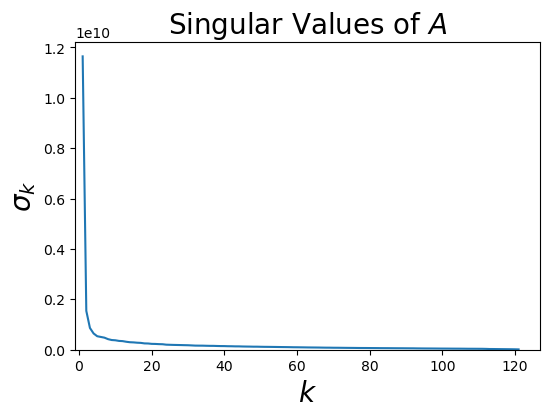
This classic, sharp-elbow tells us that a few singular values are very large, and most singular values are quite small.
Zooming in for just small \(k\) values, we can see that the elbow is around 4 - 6 singular values:
Show code cell source
fig = plt.figure(figsize = (6, 4))
Anorm = np.linalg.norm(Atraf)
plt.plot(range(1, 21), s[0:20]/Anorm, '.-')
plt.xlim([0.5, 20])
plt.ylim([0, 1])
plt.xlabel(r'$k$', size=20)
plt.xticks(range(1, 21))
plt.ylabel(r'$\sigma_k$', size=20);
plt.title(r'Singular Values of $A$',size=20);
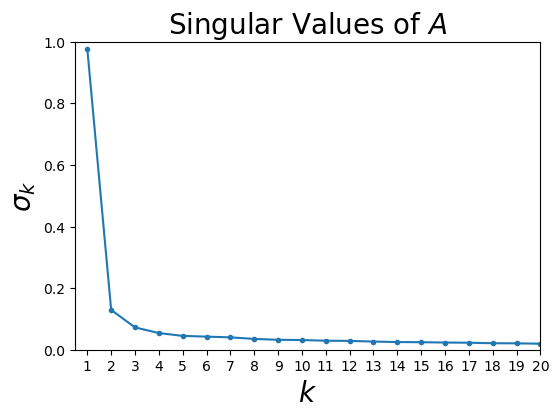
This pattern of singular values suggests low effective rank.
Let’s use the formula above to compute the relative error of a rank-\(k\) approximation to \(A\):
Show code cell source
fig = plt.figure(figsize = (6, 4))
Anorm = np.linalg.norm(Atraf)
err = np.cumsum(s[::-1]**2)
err = np.sqrt(err[::-1])
plt.plot(range(0, 20), err[:20]/Anorm, '.-')
plt.xlim([0, 20])
plt.ylim([0, 1])
plt.xticks(range(1, 21))
plt.xlabel(r'$k$', size = 16)
plt.ylabel(r'relative F-norm error', size=16)
plt.title(r'Relative Error of rank-$k$ approximation to $A$', size=16);
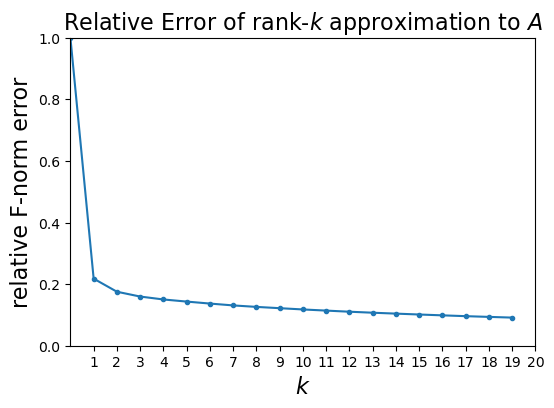
Remarkably, we are down to 9% relative error using only a rank 20 approximation to \(A\).
So instead of storing
\(mn =\) (1008 \(\cdot\) 121) = 121,968 values,
we only need to store
\(k(m+n)\) = 20 \(\cdot\) (1008 + 121) = 22,580 values,
which is a 81% reduction in size.
Low Effective Rank is Common#
In practice many datasets have low effective rank.
Here are some more examples.
Likes on Facebook.
Here, the matrices are
Number of likes: Timebins \(\times\) Users
Number of likes: Users \(\times\) Page Categories
Entropy of likes across categories: Timebins \(\times\) Users

Source: [Viswanath et al., Usenix Security, 2014]
Social Media Activity.
Here, the matrices are
Number of Yelp reviews: Timebins \(\times\) Users
Number of Yelp reviews: Users \(\times\) Yelp Categories
Number of Tweets: Users \(\times\) Topic Categories

Source: [Viswanath et al., Usenix Security, 2014]
User preferences over items.
Example: the Netflix prize worked with partially-observed matrices like this:
Where the rows correspond to users, the columns to movies, and the entries are ratings.
Although the problem matrix was of size 500,000 \(\times\) 18,000, the winning approach modeled the matrix as having rank 20 to 40.
Source: [Koren et al, IEEE Computer, 2009]
Images.
Image data often shows low effective rank.
For example, here is an original photo:
Show code cell source
boat = np.loadtxt('data/images/boat/boat.dat')
import matplotlib.cm as cm
plt.figure()
plt.imshow(boat,cmap = cm.Greys_r)
plt.axis('off');

Let’s look at its spectrum:
u, s, vt = np.linalg.svd(boat, full_matrices = False)
plt.plot(s)
plt.xlabel('$k$', size = 16)
plt.ylabel(r'$\sigma_k$', size = 16)
plt.title('Singular Values of Boat Image', size = 16);
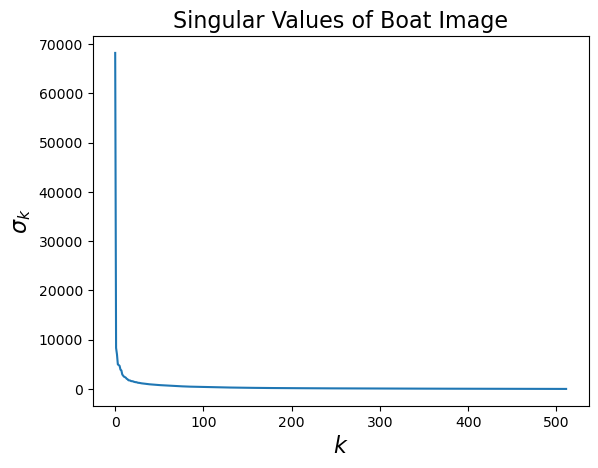
This image is 512 \(\times\) 512. As a matrix, it has rank of 512.
But its effective rank is low.
Based on the plot above, its effective rank is perhaps 40.
Let’s find the closest rank-40 matrix and view it.
u, s, vt = np.linalg.svd(boat, full_matrices = False)
s[40:] = 0
boatApprox = u @ np.diag(s) @ vt
Show code cell source
#
plt.figure(figsize=(9,6))
plt.subplot(1,2,1)
plt.imshow(boatApprox,cmap = cm.Greys_r)
plt.axis('off')
plt.title('Rank 40 Boat')
plt.subplot(1,2,2)
plt.imshow(boat,cmap = cm.Greys_r)
plt.axis('off')
plt.title('Rank 512 Boat');
# plt.subplots_adjust(wspace=0.5)

Interpretations of Low Effective Rank#
How can we understand the low-effective-rank phenomenon in general?
There are two helpful interpretations:
Common Patterns
Latent Factors
Low Rank Implies Common Patterns#
The first interpretation of low-rank behavior is in answering the question:
“What is the strongest pattern in the data?”
Using the SVD we form the low-rank approximation as
\(U' = \) the \(k\) leftmost columns of \(U\),
\(\Sigma' = \) the \(k\times k\) upper left submatrix of \(\Sigma\), and
\(V'= \) the \(k\) leftmost columns of \(V\), and constructing
with $\( A \approx U'\Sigma'(V')^T \)$
In this interpretation, we think of each column of \(A\) as a combination of the columns of \(U'\).
How can this be helpful?
Consider the set of traffic traces. There are clearly some common patterns. How can we find them?
Show code cell source
with open('data/net-traffic/AbileneFlows/odnames','r') as f:
odnames = [line.strip() for line in f]
dates = pd.date_range('9/1/2003',freq='10min',periods=1008)
Atraf = pd.read_table('data/net-traffic/AbileneFlows/X',sep=' ',header=None,names=odnames,engine='python')
Atraf.index = dates
plt.figure(figsize=(10,8))
for i in range(1,13):
ax = plt.subplot(4,3,i)
Atraf.iloc[:,i-1].plot()
plt.title(odnames[i])
plt.subplots_adjust(hspace=1)
plt.suptitle('Twelve Example Traffic Traces', size=20);
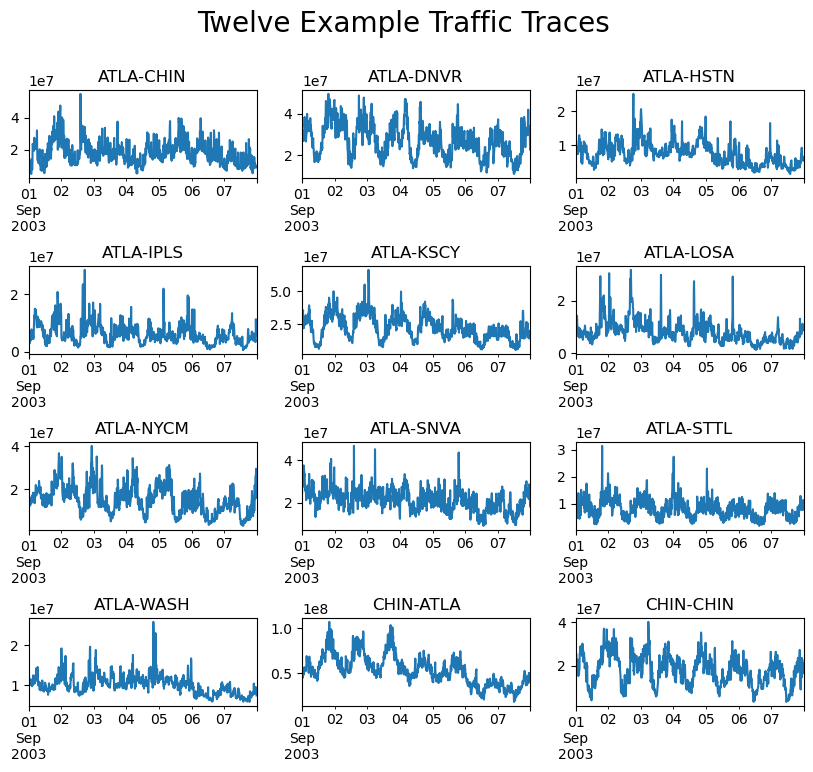
Let’s use as our example \(\mathbf{a}_1,\) the first column of \(A\).
This happens to be the ATLA-CHIN flow.
The equation above tells us that
In other words, \(\mathbf{u}_1\) (the first column of \(U\)) is the “strongest” pattern occurring in \(A\), and its strength is measured by \(\sigma_1\).
Here is an view of the first 2 columns of \(U\Sigma\) for the traffic matrix data.
These are the strongest patterns occurring across all of the 121 traces.
Show code cell source
u, s, vt = np.linalg.svd(Atraf, full_matrices = False)
uframe = pd.DataFrame(u @ np.diag(s), index=pd.date_range('9/1/2003', freq = '10min', periods = 1008))
uframe[0].plot()
uframe[1].plot()
plt.title('First Two Columns of $U$');
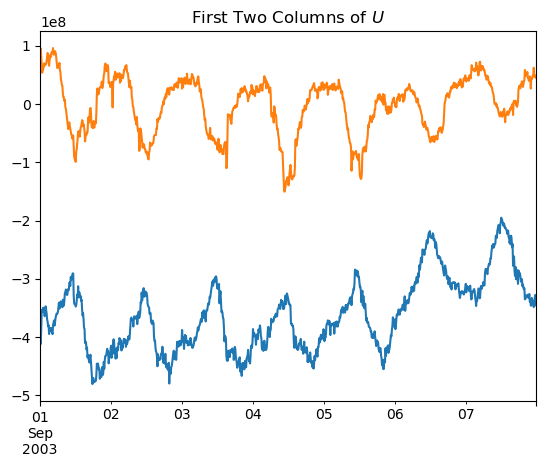
Low Rank Defines Latent Factors#
The next interpretation of low-rank behavior is that it exposes “latent factors” that describe the data.
Returning to the low-rank decomposition:
In this interpretation, we think of each element of \(A\) as the inner product of a row of \(U'\Sigma'\) and a row of \(V'\).
Let’s say we are working with a matrix of users and items.
In particular, let the items be movies and matrix entries be ratings, as in the Netflix prize.
Recall the structure from a previous slide:
Then the rating that a user gives a movie is the inner product of a \(k\) element vector that corresponds to the user, and a \(k\) element vector that corresponds to the movie.
In other words:
We can therefore think of user \(i\)’s preferences as being captured by \(\mathbf{u}_i\), ie., a point in \(\mathbb{R}^k\).
We have described everything we need to know to predict user \(i\)’s ratings via a \(k\)-element vector.
The \(k\)-element vector is called a latent factor.
Likewise, we can think of \(\mathbf{v}_j\) as a “description” of movie \(j\) (another latent factor).
The value in using latent factors comes from the summarization of user preferences, and the predictive power one obtains.
For example, the winning entry in the Netflix prize competition modeled user preferences with a 20-element latent factor.
The remarkable thing is that a person’s preferences for all 18,000 movies can be reasonably well captured in a 20-element vector!
Here is a figure from the paper that described the winning strategy in the Netflix prize.
It shows a hypothetical latent space in which each user, and each movie, is represented by a latent vector.
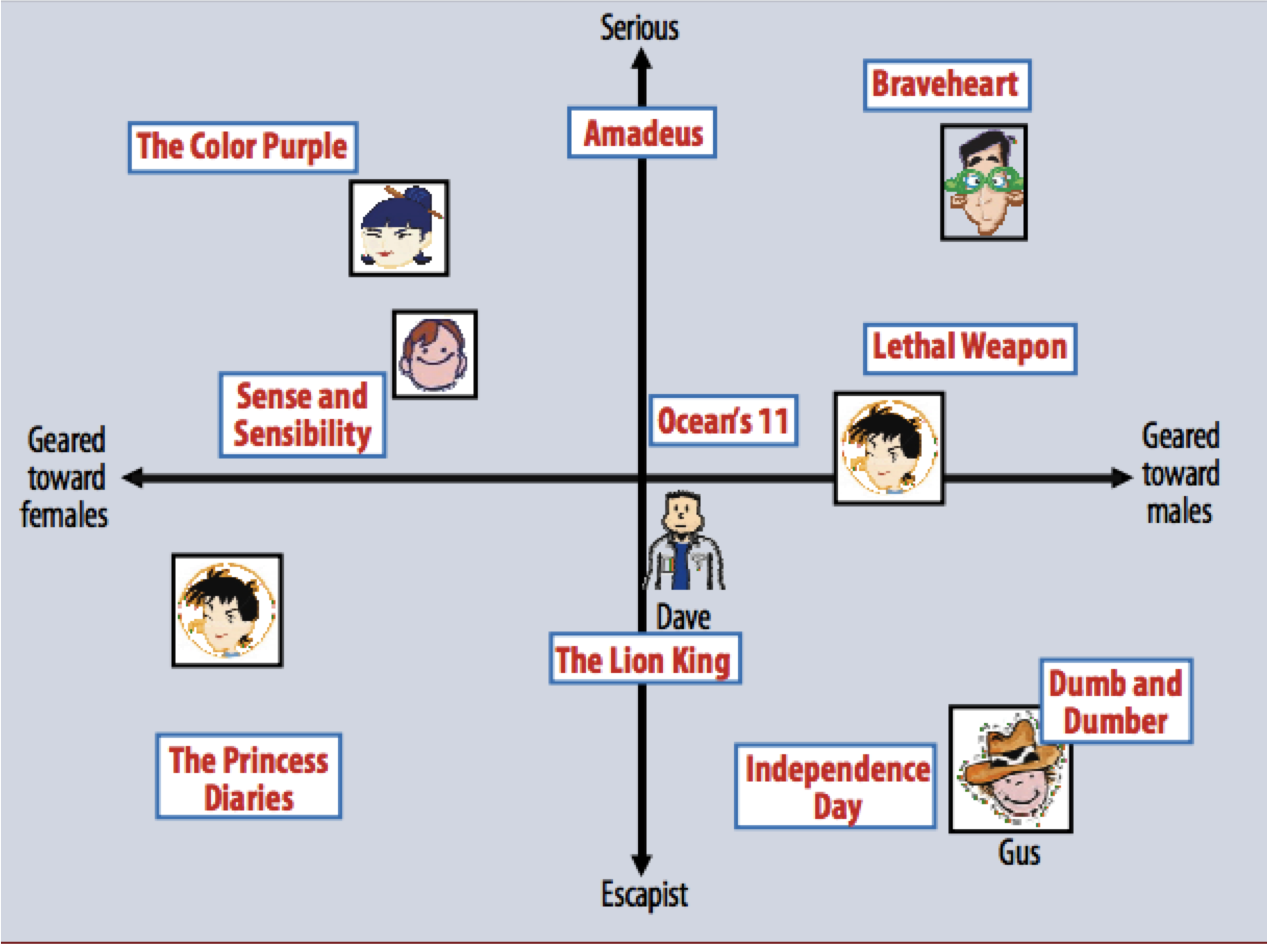
Source: Koren et al, IEEE Computer, 2009
In practice, this is perhaps a 20- or 40-dimensional space.
Here are some representations of movies in that space (reduced to 2-D).
Notice how the space seems to capture similarity among movies!
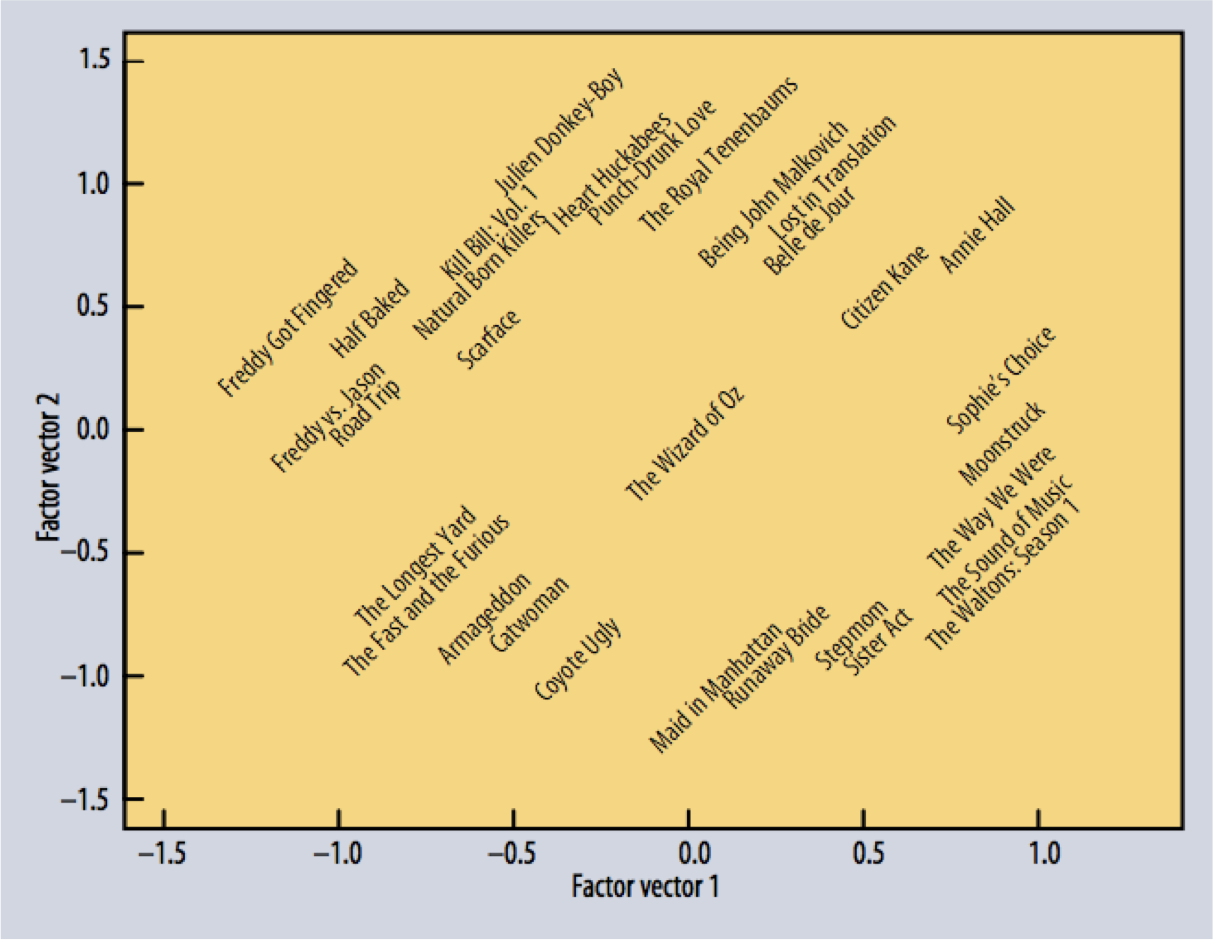
Source: Koren et al, IEEE Computer, 2009
Summary#
When we are working with data matrices, it is valuable to consider the effective rank
Many (many) datasets in real life show low effective rank.
This property can be explored precisely using the Singular Value Decomposition of the matrix.
When low effective rank is present,
the matrix can be compressed with only small loss of accuracy
we can extract the “strongest” patterns in the data
we can describe each data item in terms of the inner product of latent factors.